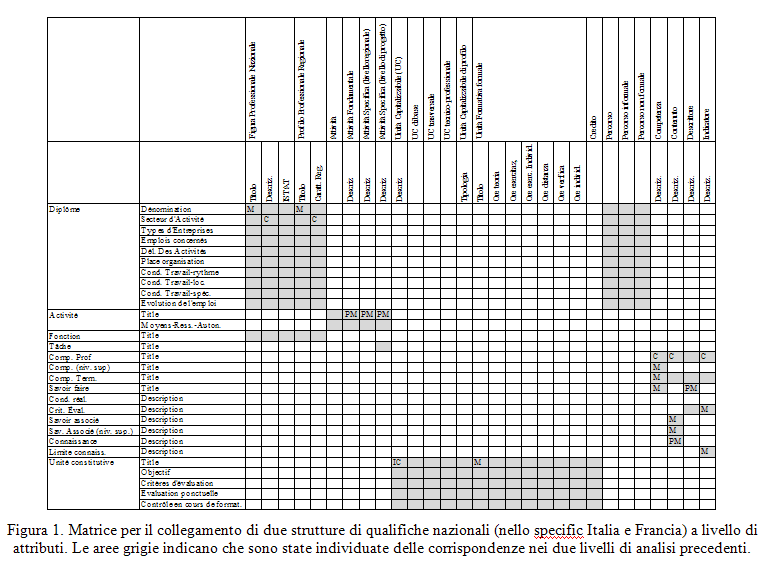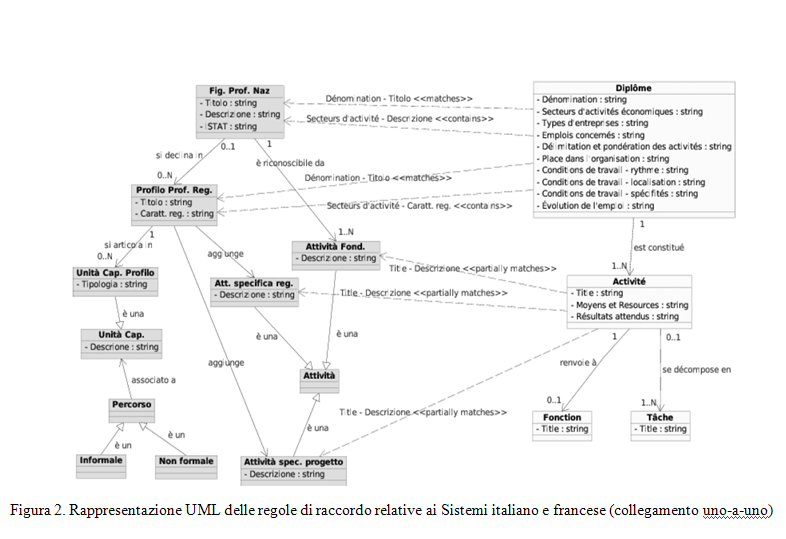ECVET - Application to mobility projects
Main menu:
- Home Page
- ECVET - Overview
- ECVET - Key topics
- Sesamo and ECVET
- User guide
- Coordinator - Supervisor guide
Methodology
Sesamo and ECVET > Vetlinks
Phases
The process that has been pursued in the overall development of the Vetlinks platform can be divided in two phases.
In the first phase, formal models of the national systems developed in the H.E.LE.N. project were analyzed and updated by making reference to the UML notation (originally selected in the reference project); then referencing/linking matrices were developed to qualitatively assess the match between couples of country-based structures. Linking matrices were then filled in by national experts involved in VET training provision. Matrix-based comparison was carried out at three levels by analyzing:
1. National rules and regulations; the comparison did not considered concrete study cases and it worked only at the concept level (using national regulation for the definition of a qualification);
2. instances: the comparison focused on qualification content (in other words, concrete study cases);
3. attributes: concepts and instances were analyzed at the attribute level (taking into account single elements specifying concepts and instances, i.e. "Title", "Description", etc.).
Then, experts were asked to analyze couples of country-based systems and qualifications at each one of the three levels of details described above, and to insert into referencing matrices the values expressing the outcome of the comparison. Specifically, for each level of comparison, experts followed the strategy depicted below:
1. concept level: every intersection between two concepts belonging to the given matrix could have three different values, depending on the particular relation between related concepts belonging to a given couple of qualification structures:
a. "E" when the two concepts have exactly the same meaning;
b. "S" when the concepts do not have exactly the same meaning, but in practical terms they denote similar elements;
c. "N" when concepts are not comparable at all.
2. Instance level: information concerning instances are inserted into the previous matrix by extending it: in this case, each intersection is allowed to assume two values, where the first one is used to recall the link established at the concept level, while the second one is used to identify the relation found at the instance level. Possible values are reported below:
a. "E/E" , "E/S", "E/N" show the fact that the two concepts have exactly the same meaning, while instances could have exactly the same meaning (first situation), could have a similar meaning (second situation) or could be not comparable at all (third situation);
b. "S/E", "S/S", "S/N", show the fact that the two concepts have a similar meaning, while instances could have exactly the same meaning (first situation), could have a similar meaning (second situation) or could be not comparable at all (third situation);
c. "N/E", "N/S", "N/N" show the fact that the two concepts are not comparable at all, while instances could have exactly the same meaning (first situation), could have a similar meaning (second situation) or could be not comparable at all (third situation).
It is worth remarking that, in the extended matrix, new relationships could be unveiled, previously not appreciable at the concept level.
Results of the analysis carried out at concept and instance level were used to create the matrices at the attribute level.
3. attribute level: in this phase, both concepts and instances are analyzed at the attribute level, by comparing elements composing a concept or an instance. The previous matrix was re-considered by further extending it with details about attributes, as it is shown in Figure 1.
In this new matrix, each intersection between attributes concerning two specific national qualifications could host one of the following values:
a. "C", the source element contains the target element;
b. "IC", the source element is completely contained in the target element;
c. "PC", the source element partially contains the target element;
d. "IPC", the source element is partially contained in the target element;
e. "M", the source element and the target element match;
f. "PM", the source element and the target element partially match;
g. "N", the source element is not covered by the target element at all.
Figure 1. Matrix for linking two national qualification structures (specifically, for Italy and France) at the attribute level. Gray areas indicate that a match has been identified in the previous two levels of the analysis.
In the second phase, the two matrices - concept/instance level and attribute level - filled in with data obtained from national rules and study cases represent the starting point for the construction of a formal and easy-to-read representation of the referencing rules. As for the first phase, this representation is based on the UML notation, and extends national models described in the H.E.LE.N. project.
To enrich the expressiveness of the UML relationships, stereotypes (like "<<matches>>", "<<partially matches>>", etc.) were added to the models, by making reference to possible match values. As a matter of example, Figure 2 reports an excerpt of the meta-model or meta-ontology for the French and Italian systems at the attribute level. The example shows that the French Dénomination attribute is equivalent to the Italian Titolo. On the other hand, the French attribute Secteur d'activité contains information that is included in the Italian Descrizione attribute (thus, they do not match completely).
This graphics representation played a fundamental role in the creation of the formal rules exploited for qualification comparison, because it proved to be capable of immediately indicating where (in a "target", e.g. foreign, qualification) a semantic engine should look for in order to find information comparable with data belonging to the "source" (e.g. national) profile. Being based on a visual language, it also allowed VET experts to validate the models before the implementation of the software-based referencing rules.
Finally, with respect to the overall approach, it is worth observing that the mechanism analyzed in the project, based on a one-to-one referencing strategy, could be allowed to easily evolve into a top-down one, as soon as the European instrument would be fully implemented by Member States, by 2012. Moreover, the proposed one-to-one strategy has the implicit advantage to analyze country-to-country relations, that represent a specification of the more general country-to-EQF scenario that can be used in real mobility circumstances. In the following, the country-to-country and country-to-EQF semantic comparison experienced in the S.E.S.A.M.O. project will be considered in details.

Figure 2. UML-based representation of the rules for referencing Italian and French models (one-to-one linking).